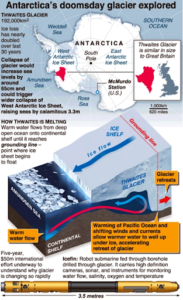In news– Scientists studying Antarctica’s vast Thwaites Glacier – nicknamed the Doomsday Glacier say warm water is seeping into its weak spots, worsening melting caused by rising temperatures.
Key findings-
- Thwaites, which is roughly the size of Florida, represents more than half a meter (1.6 feet) of global sea level rise potential, and could destabilise neighbouring glaciers that have the potential to cause a further three-meter (9.8-foot) rise.
- As part of the International Thwaites Glacier collaboration – the biggest field campaign ever attempted in Antarctica – a team of 13 U.S. and British scientists spent about six weeks on the glacier in late 2019 and early 2020.
- Using an underwater robot vehicle known as Icefin, mooring data and censors, they monitored the glacier’s grounding line, where ice slides off the glacier and meets the ocean for the first time.
- In one of the papers of Cornell University, researchers found that warmer water was making its way into crevasses and other openings known as terraces, causing sideways melt of 30 meters (98 feet) or more per year.
- The other paper’s findings, showed about five meters (16 feet) per year of melt near the glacier’s grounding line – less than what the most aggressive thinning models previously predicted.
- Scientists have previously depended on satellite images to show the behaviour of the ice, making it difficult to get granular details.
- The papers represent the first time a team has been to the grounding line of a major glacier, providing a look right where the action begins..
- The findings will help in the development of climate change models. These things can now be taken on board in the models that will predict the future behaviour.
About Thwaites Glacier-
- Thwaites Glacier, nicknamed the Doomsday Glacier, is an unusually broad and vast Antarctic glacier flowing into Pine Island Bay, part of the Amundsen Sea, east of Mount Murphy, on the Walgreen Coast of Marie Byrd Land.
- Its surface speeds exceed 2 kilometres per year near its grounding line.
- Its fastest-flowing grounded ice is centered between 50 and 100 kilometres (31 and 62 mi) east of Mount Murphy. In 1967, the Advisory Committee on Antarctic Names named the glacier after Fredrik T.
- Thwaites Glacier is closely monitored for its potential to raise sea levels.
- Along with the Pine Island Glacier, it has been described as part of the “weak underbelly” of the West Antarctic Ice Sheet, because of its apparent vulnerability to significant retreat.

















